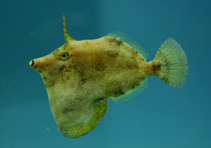| Family: |
Monacanthidae (Filefishes) |
| Max. size: |
20 cm TL (male/unsexed) |
| Environment: |
reef-associated; marine; depth range 1 - 50 m |
| Distribution: |
Western Atlantic: Newfoundland (Canada), Bermuda, and northern Gulf of Mexico to Argentina, including the Caribbean (Ref. 3790). Eastern Atlantic. |
| Diagnosis: |
Dorsal spines (total): 2-2; Dorsal soft rays (total): 29-37; Anal spines: 0-0; Anal soft rays: 28-36. Snout prominently projecting but not very elongate; first dorsal spine originating above posterior part of eye; adult males with two pairs of enlarged recurved spines on each side of caudal peduncle; spines of females only slightly larger than other scale spinules of caudal peduncle (Ref. 13442). |
| Biology: |
Occurs in shallow water down to 50 m depth, over sandy and rocky bottoms, but more commonly in grass beds (Ref. 3790). Often seen moving head down among seagrass blades (Ref. 9710). The young are often associated with floating Sargassum (Ref. 3720). Feeds on plants and algae, and also on small crustaceans (Ref. 3720). Rarely consumed (Ref. 3790). |
| IUCN Red List Status: |
Least Concern (LC); Date assessed: 10 September 2014 Ref. (130435)
|
| Threat to humans: |
reports of ciguatera poisoning |
Source and more info: www.fishbase.org. For personal, classroom, and other internal use only. Not for publication.

